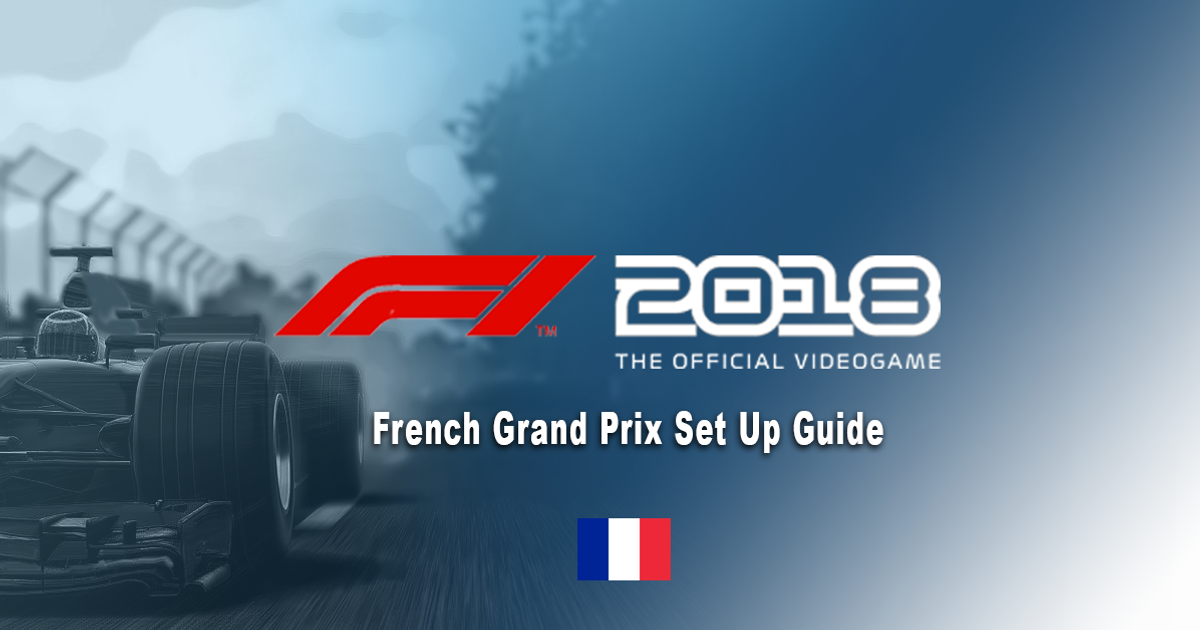The French Grand Prix disappeared from the Formula 1 calendar at the end of the 2008 season, and there never really looked like a time it would come back. Suddenly, Renault were back in F1 and the interest took off again. This F1 2018 sees the return of the French Grand Prix, now at the Circuit Paul Ricard near Marseille. It is the first time F1 has visited the circuit since 1990, making it a brand new track for players to conquer in Formula 1 games.
Paul Ricard is a series of twisty, late apex, corners broken up by the massive Mistral straight. That means you need to create a responsive front end and a rear with good traction that doesn't create too much drag down the straight. How can we do that?
Aerodynamics
Due to the flat out Courbe des Signes as well as several curved acceleration/braking zones we can't just trim all the wing off the car like we would in Monza to maximise straight line speed. In fact, you need more rear downforce to improve grip through the corners and traction out of them. One benefit of Paul Ricard is that it is exceptionally flat with an excellent surface. Because of that, you don't need as much front wing as you may think because you can add responsiveness elsewhere.
Transmission
Differential adjustments are vital around Paul Ricard because of just how much lifting and accelerating during cornering. Getting this part of the setup right will shave huge amounts of time off your lap. It's a more aggressive locked up on throttle differential to provide good traction onto the Mistral straight. While that increases tyre wear, Paul Ricard is exceptionally kind to tyres so the car can be set up to extract extra performance from them. Off throttle differential is left alone, this is because further unlocking would reduce traction and further locking would add understeer to the car, a problem for a lot of the late apexes.
Suspension Geometry
Thanks to the kind surface of this track we can be a little more aggressive with our suspension geometry and use the mechanical grip on offer. We add some negative camber to the front tyres to improve cornering grip and take a little off the rear to aid traction. Because there is added camber, take away a little of the toe on the front so it is more stable. Reduce the toe of the rear tyres as you don't have to counter so much toe out on the front. This makes the car a little more responsive on the back end and while it reduces straight line traction, it helps with acceleration under lateral load.
Suspension
The kind nature of the circuit means you can soften the suspension allowing us ride the kerbs more comfortably and makes the car a more predictable to drive. By bringing down the rear suspension slightly we allow weight to shift to the rear under acceleration, improving traction.
The anti-roll bars have been left alone as stiffer bars may improve initial responsiveness, but at a severe cost to tyre wear. Since the tyres have been stressed with the suspension geometry and there are not too many quick changes of direction, you don't need to stiffen them. Reducing them would cost us the responsiveness we have worked hard to create.
We have created a rake by lowering the ride height of the front more than the rear. This helps create some oversteer to dart into these tightening corners.
Brakes
Pumping up the brake pressure shortens stopping distances, but it does also increase the potential for lock ups. More brake pressure is needed thanks to the chicane in the middle of the Mistral straight. It is the primary overtaking point on the circuit so having a shorter stopping distance is vital to both gaining places and defending from faster cars behind. It does make some other corners trickier, but throttle control can save you in corners like Double Droite De Beausset and Virage du Lac where the apex is very late and you need to reduce our speed gradually.
By shifting the brake bias rearward we create oversteer to get the nose in. This is particularly useful in the tight final corner Virag du Pont which leads into the DRS zone down the pit straight.
Tyres
Do not play with tyre pressure too much. Leave the front tyres as they are since it is a good balance between cornering grip, responsiveness, and wear. With the rears take some air out to increase the contact patch with the ground and thus increase traction. This does increase wear a little but, Paul Ricard is very kind to tyres so we can get away with it.
Weight Distribution
Shifting the weight ballast to the rear a touch helps generate yet more traction and oversteer, complimenting the rest of the setup. You aren't going to fly past other drivers on the Mistral straight but even in a Renault-powered car you won't get left behind, meanwhile you are agile enough to dart through the rest of the circuit and even make overtaking attempts at uncommon parts of the circuit.
This setup will need fine-tuning to your specific driving style and use of driver assists, but it is a very good place to start from while you learn the track and discover your racing line. See you on the time sheets!
French Grand Prix Wet Lap Setup
Front Wing: 5
Rear Wing: 7
On Throttle: 55%
Off Throttle: 85%
Front Camber: -2.50
Rear Camber: -1.00
Front Toe: 0.05
Rear Toe: 0.20
Front Suspension: 5
Rear Suspension: 3
Front Anti-Roll Bar: 9
Rear Anti-Roll Bar: 7
Front Ride Height: 3
Rear Ride Height: 4
Brake Pressure: 88%
Front Brake Bias: 55%
Front Tyre Pressure: 23.4 psi
Rear Tyre Pressure: 21.1 psi
Ballast: 7
Explore new topics and discover content that's right for you!





